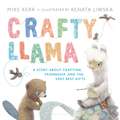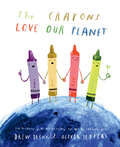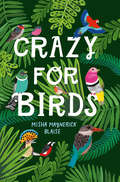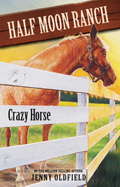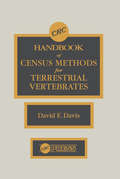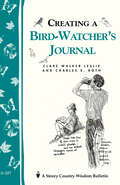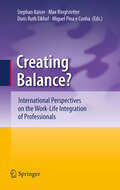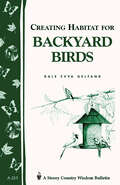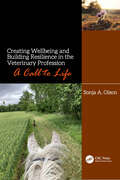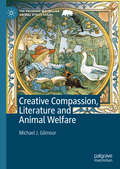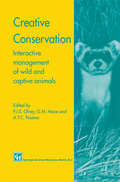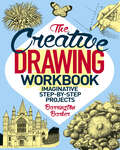- Table View
- List View
Crafty Llama
by Renata Liwska Mike KerrA darling new character from New York Times bestselling illustrator Renata Liwska! Created with author Mike Kerr, this is a story about crafting, friendship, and the very best gifts, perfect for fans of Extra Yarn.Llama loves to make things. It doesn't matter what, really--something special, something lovely. Beaver loves to make things, too. But he likes things to be useful. On this lovely day, Llama is inspired. She is having fun making things, like gifts for her friends. And soon many of her friends are inspired right along with her. But Beaver needs to think about what Llama and the other animals are making. What useful thing can he do with this day? With lots of craftiness and fun, this is a delightful story about how something lovely can be useful, too, and how the best gifts are the ones that bring us together.
Crate Training Your Dog: Storey's Country Wisdom Bulletin A-267 (Storey Country Wisdom Bulletin)
by Pat StorerEase Your Mind And Indulge Your Dog!If you want your dog to feel safe and secure in your home, it's time to crate train! A crate is designed as much for a dog's well-being as it is for the owner's convenience and peace of mind. For example, a crate keeps a curious puppy away from chemicals under the kitchen sink, gives a sick or convalescing dog a quiet place to rest, and secures a rambunctious dog during car trips.Crate training works because dogs, like their wild ancestors, desire a snug "den" that affords security and privacy. When dogs are crate trained properly, they accept and even enjoy their sequestered time. Pat Storer shows you how to maintain a positive, loving attitude while being firm and consistent with your dog. With Storer's advice on choosing the right crate, step-by-step instructions, and tips for dealing with crate-related behavior problems, both you and your dog will find crate training to be a simple, successful experience.
Crayfishes, Lobsters and Crabs of Europe: An Illustrated Guide to common and traded species
by R. IngleFishermen, marine aquarists, biologists studying seashore and coastal waters, and those involved in trading shellfish and even restaurateurs are aware of the great diversity of crustaceans inhabiting the seas around the British Isles, Northern Europe and the Mediterranean. Crayfishes, Lobsters and Crabs of Europe will enable the reader to identify 42 crustacean species of commercial importance found in these regions during coastal explorations, fishing trips, displayed in public aquaria or available in restaurants, including selected freshwater crayfishes, deep-sea species and some imported species. The book also includes sections on the gross internal and external structure of these Crustacea, their life histories, classification and nomenclature. The book is of interest to students of marine biology and researchers in fisheries science.
The Crayons Love our Planet
by Drew DaywaltThe crayons from the #1 New York Times bestselling The Day the Crayons Quit are ready to celebrate our planet!
Crazy for Birds: Fascinating And Fabulous Facts
by Misha Maynerick BlaiseA charming and quirky illustrated exploration of birds and the reasons we love them.
Crazy Horse: Book 3 (Horses of Half Moon Ranch #3)
by Jenny OldfieldCrazy Horse - wild and unruly, and Cadillac - a beautiful pedigree, are two very different but inseparable horses. When both horses are discovered to be missing one night, it seems that Crazy Horse was used by thieves to lure Cadillac away. Kirstie is worried about what they will do with Crazy Horse - but will she track the stolen horses down in time?
CRC Handbook of Census Methods for Terrestrial Vertebrates
by David E DavisLearn how to start a census program for terrestrial vertebrates with this handbook. Whether the information you need is for managing a population, surveying environmental impact, or conducting research on a particular species, this handbook has it all. Principles, methods, and calculations are explained. The following information is given for each species: name; range; reasons for census; life history; items of importance, e.g., migration; methods of census; recent and pertinent references; and comments about the various methods.
CRC Handbook of Census Methods for Terrestrial Vertebrates
by David E DavisLearn how to start a census program for terrestrial vertebrates with this handbook. Whether the information you need is for managing a population, surveying environmental impact, or conducting research on a particular species, this handbook has it all. Principles, methods, and calculations are explained. The following information is given for each species: name; range; reasons for census; life history; items of importance, e.g., migration; methods of census; recent and pertinent references; and comments about the various methods.
CRC Handbook of Marine Mammal Medicine
by Frances Gulland Leslie A. Dierauf Karyl L. WhitmanAAP Prose Award Finalist 2018/19 For three decades, this book has been acknowledged as the most respected scientific reference specifically devoted to marine mammal medicine and health. Written by approximately 100 contributors who are recognized globally as leaders in their respective fields, the CRC Handbook of Marine Mammal Medicine, Third Edition continues to serve as the essential guide for all practitioners involved with marine mammals including veterinarians, technicians, biological researchers, students, managers, keepers, curators, and trainers. The 45 chapters provide essential information for the practitioner on pathology, infectious diseases, medical treatment, anesthesia, surgery, husbandry, health assessment, species-specific medicine, medically pertinent anatomy and physiology, and global health concerns such as strandings, oil spills, and entanglements of marine mammals. Covers all aspects of marine mammal veterinary practice Written by internationally acknowledged experts Adds new chapters on Ophthalmology, Dentistry, Ethics, Oil Spill Response, Health Assessments, Whale Entanglement Response, Dive Response, and Biotoxins Richly illustrated in color throughout the new edition including updated anatomical drawings and extensive photographs of ocular lesions Provides guidance to websites that regularly present updated information and images pertinent to current marine mammal medicine such as imaging and stranding network contacts Discusses ethics and animal welfare. The book guides the reader through the veterinary care of cetaceans, pinnipeds, manatees, sea otters, and polar bears. In addition to summaries of current knowledge, chapters provide information on those digital resources and websites which present the latest information as it emerges in the field. The CRC Handbook of Marine Mammal Medicine, Third Edition gives a call to action for scientists to experiment with new endeavors to engage and inspire current and future generations to care for marine mammals and the marine environment, and work together to find solutions. As the most trusted reference for marine mammal conservation medicine and for marine mammal medical facilities around the world, this book needs to be in your library.
CRC Handbook of Marine Mammal Medicine
by Frances M. D. Gulland Leslie A. Dierauf Karyl L. WhitmanAAP Prose Award Finalist 2018/19 For three decades, this book has been acknowledged as the most respected scientific reference specifically devoted to marine mammal medicine and health. Written by approximately 100 contributors who are recognized globally as leaders in their respective fields, the CRC Handbook of Marine Mammal Medicine, Third Edition continues to serve as the essential guide for all practitioners involved with marine mammals including veterinarians, technicians, biological researchers, students, managers, keepers, curators, and trainers. The 45 chapters provide essential information for the practitioner on pathology, infectious diseases, medical treatment, anesthesia, surgery, husbandry, health assessment, species-specific medicine, medically pertinent anatomy and physiology, and global health concerns such as strandings, oil spills, and entanglements of marine mammals. Covers all aspects of marine mammal veterinary practice Written by internationally acknowledged experts Adds new chapters on Ophthalmology, Dentistry, Ethics, Oil Spill Response, Health Assessments, Whale Entanglement Response, Dive Response, and Biotoxins Richly illustrated in color throughout the new edition including updated anatomical drawings and extensive photographs of ocular lesions Provides guidance to websites that regularly present updated information and images pertinent to current marine mammal medicine such as imaging and stranding network contacts Discusses ethics and animal welfare. The book guides the reader through the veterinary care of cetaceans, pinnipeds, manatees, sea otters, and polar bears. In addition to summaries of current knowledge, chapters provide information on those digital resources and websites which present the latest information as it emerges in the field. The CRC Handbook of Marine Mammal Medicine, Third Edition gives a call to action for scientists to experiment with new endeavors to engage and inspire current and future generations to care for marine mammals and the marine environment, and work together to find solutions. As the most trusted reference for marine mammal conservation medicine and for marine mammal medical facilities around the world, this book needs to be in your library.
CRC Handbook of the Zoology of Amphistomes (CRC Press Revivals)
by Otto SeyHandbook of the Zoology of Amphistomes provides a comprehensive survey on the morphology, ecology, systematics, and zoogeography of amphistomes, which are a group of digenetic trematodes parasitic in vertebrates. The handbook features the special morphological characteristics of amphistomes, including the structure and types of muscular organs; a short diagnosis for each species (when possible), as well as a line drawing of each adult fluke; a zoogeographical analysis, including the host-parasite coevolution, distributional patterns, and characterization of faunas within the zoogeographical realm; and a possible evolutionary scenario based on holomorphological characteristics. Parasitologists, helminthologists, zoologists, and biologists working with ecological associations will find this book an essential reference source for their work with amphistomes.
CRC Handbook of the Zoology of Amphistomes (CRC Press Revivals)
by Otto SeyHandbook of the Zoology of Amphistomes provides a comprehensive survey on the morphology, ecology, systematics, and zoogeography of amphistomes, which are a group of digenetic trematodes parasitic in vertebrates. The handbook features the special morphological characteristics of amphistomes, including the structure and types of muscular organs; a short diagnosis for each species (when possible), as well as a line drawing of each adult fluke; a zoogeographical analysis, including the host-parasite coevolution, distributional patterns, and characterization of faunas within the zoogeographical realm; and a possible evolutionary scenario based on holomorphological characteristics. Parasitologists, helminthologists, zoologists, and biologists working with ecological associations will find this book an essential reference source for their work with amphistomes.
Creating a Bird-Watcher's Journal: Storey's Country Wisdom Bulletin A-207 (Storey Country Wisdom Bulletin)
by Clare Walker Leslie Charles E. RothSince 1973, Storey's Country Wisdom Bulletins have offered practical, hands-on instructions designed to help readers master dozens of country living skills quickly and easily. There are now more than 170 titles in this series, and their remarkable popularity reflects the common desire of country and city dwellers alike to cultivate personal independence in everyday life.
Creating Africas: Struggles Over Nature, Conservation and Land
by Knut NustadIn Africa, conflicts between protected areas for fauna and flora and space for their surrounding human populations continue despite years spent trying to find an accommodation between the needs of both parties. Creating Africas investigates the roots of the current conservation boom, demonstrates that it is part of a struggle over various definitions of existing realities, and examines the global effects of this struggle. The book discusses the first UNESCO World Heritage Site in South Africa, the Isimangaliso (St Lucia) Wetland Park. Here, conservation interests are pitted against those of industrial forestry, commercial farming, and local communities struggling to have their lands returned to them. They all seek to define and create their own realities, but do so with very different resources at their disposal. In his expert analysis, Nustad treats these realities not as different representations but rather as multiple, often competing, viewpoints that involve a wide range of actors, both human and non-human. Nustad posits that in order to avoid being accused of neo-colonial land grabbing, the conservation lobby will need to find a new way of imagining nature and protection that includes people.
Creating Africas: Struggles Over Nature, Conservation and Land
by Knut NustadIn Africa, conflicts between protected areas for fauna and flora and space for their surrounding human populations continue despite years spent trying to find an accommodation between the needs of both parties. Creating Africas investigates the roots of the current conservation boom, demonstrates that it is part of a struggle over various definitions of existing realities, and examines the global effects of this struggle. The book discusses the first UNESCO World Heritage Site in South Africa, the Isimangaliso (St Lucia) Wetland Park. Here, conservation interests are pitted against those of industrial forestry, commercial farming, and local communities struggling to have their lands returned to them. They all seek to define and create their own realities, but do so with very different resources at their disposal. In his expert analysis, Nustad treats these realities not as different representations but rather as multiple, often competing, viewpoints that involve a wide range of actors, both human and non-human. Nustad posits that in order to avoid being accused of neo-colonial land grabbing, the conservation lobby will need to find a new way of imagining nature and protection that includes people.
Creating Balance?: International Perspectives on the Work-Life Integration of Professionals
by Stephan Kaiser, Max Josef Ringlstetter, Doris Ruth Eikhof and Miguel Pina e CunhaA satisfactory and healthy integration of work with other life domains is one of the key challenges of modern society. Work-life balance and work-life integration have become focal points of today’s human resource management practice and theory. Professionals who have been described as “extreme workers” regarding their work hours and engagement are under particular pressure to balance work and ”the rest of life”.This collection maps the increasingly extensive discussion of work-life issues for professionals and discusses key aspects in depth. What is work-life integration? What are the specific challenges for professionals? How do they manage their blurred work-life boundaries? How can companies intervene? Internationally leading authors discuss antecedents and individual and organizational outcomes of work-life integration, gender-specific perspectives and challenges as well as the use and usefulness of corporate work-life balance initiatives. In five sections distinguished researchers from across the world present experiences and research findings to provide a compendium of academic and applied research on the work-life integration of professionals. Cutting-edge research and novel theoretical perspectives make this collection a source of knowledge and inspiration for academic and business audiences interested in work-life integration issues in general and in the case of professionals in particular.
Creating Habitat for Backyard Birds: Storey's Country Wisdom Bulletin A-215 (Storey Country Wisdom Bulletin)
by Dale Evva GelfandSince 1973, Storey's Country Wisdom Bulletins have offered practical, hands-on instructions designed to help readers master dozens of country living skills quickly and easily. There are now more than 170 titles in this series, and their remarkable popularity reflects the common desire of country and city dwellers alike to cultivate personal independence in everyday life.
Creating Wellbeing and Building Resilience in the Veterinary Profession: A Call to Life
by Sonja A. OlsonA Call to Life aims to help veterinary caregivers increase self-efficacy, decrease unnecessary suffering, and increase sustainability in their mission to support animal health around the world. The veterinary profession is powered by dedicated, bright, and selfless individuals. Unfortunately, the long-standing and dysfunctional culture in classrooms and practices around the world expects veterinary caregivers to be ready to sacrifice everything – their time, their health, their personal lives – in the name of being deemed qualified and ‘worthy.’ Integrating real-life stories from a range of veterinary caregivers with evidence-based theory, practical activities, discussion and reflection points, and insights drawn from the author’s own experiences, the book empowers veterinarians by showing that they have the ability and the control to choose a healthier way forward for themselves and for their profession. It describes how to: Normalize the conversation around mental and emotional health challenges in caregiving environments Discuss and collaboratively create systemic solutions that promote healthier ‘ecosystems’ for vets to work within Develop the skills of reframing, mindfulness, and self-care strategy implementation supporting holistic veterinary well-being Collectively choose to shift the framework of professional conversations towards psychological safety, optimism, and purpose-driven experiences. Creating Wellbeing and Building Resilience in the Veterinary Profession: A Call to Life uniquely combines shared experiences (personal stories) with academic research into the contributing factors of compassion fatigue and how to counter these. Normalizing the conversation in the profession, it provides a wide array of possible solutions to build resilience and to shape a culture of collaboration and support where caregivers can flourish.
Creating Wellbeing and Building Resilience in the Veterinary Profession: A Call to Life
by Sonja A. OlsonA Call to Life aims to help veterinary caregivers increase self-efficacy, decrease unnecessary suffering, and increase sustainability in their mission to support animal health around the world. The veterinary profession is powered by dedicated, bright, and selfless individuals. Unfortunately, the long-standing and dysfunctional culture in classrooms and practices around the world expects veterinary caregivers to be ready to sacrifice everything – their time, their health, their personal lives – in the name of being deemed qualified and ‘worthy.’ Integrating real-life stories from a range of veterinary caregivers with evidence-based theory, practical activities, discussion and reflection points, and insights drawn from the author’s own experiences, the book empowers veterinarians by showing that they have the ability and the control to choose a healthier way forward for themselves and for their profession. It describes how to: Normalize the conversation around mental and emotional health challenges in caregiving environments Discuss and collaboratively create systemic solutions that promote healthier ‘ecosystems’ for vets to work within Develop the skills of reframing, mindfulness, and self-care strategy implementation supporting holistic veterinary well-being Collectively choose to shift the framework of professional conversations towards psychological safety, optimism, and purpose-driven experiences. Creating Wellbeing and Building Resilience in the Veterinary Profession: A Call to Life uniquely combines shared experiences (personal stories) with academic research into the contributing factors of compassion fatigue and how to counter these. Normalizing the conversation in the profession, it provides a wide array of possible solutions to build resilience and to shape a culture of collaboration and support where caregivers can flourish.
The Creative Animal: How Every Animal Builds its Own Existence
by Roberto MarchesiniThis book deals with the theme of creativity in the animal world, conceived as a basic function for adapting to specific situations and as a source of innovations and inventions. Creativity is a fundamental resource for the individual who always has a leading role in conduct. To explain creativity, the book focuses on the concept of animal subjectivity, providing a new explanatory model of behavior capable of overcoming the image of the animal moved by automatisms. This model does not use consciousness as a necessary condition, but is based: 1) on affective components, such as behavioral motives, and 2) cognitive, as tools used by the subject to carry out his purposes. Particular attention is paid to the learning processes showing the subjective character of the experience. One topic addressed is the role of creativity in the evolution of living beings: how an invention, by modifying the niche characteristics, is able to change the selective pressures and the trajectory of phylogeny. Roberto Marchesini explains that creativity is a factor that is anything but rare or exceptional in the animal world—it constitutes a fundamental quality for many aspects of animal life.
Creative Compassion, Literature and Animal Welfare (The Palgrave Macmillan Animal Ethics Series)
by Michael J. GilmourThis book examines animal welfare themes in fiction, and considers how authors of the last two centuries undermine dominative attitudes toward the nonhuman. Appearing alongside the emerging humane movements of the nineteenth century and beyond is a kind of storytelling sympathetic to protectionist efforts well-described as a literature of protest. Compassion-inclined tales like the Dolittle adventures by Hugh Lofting educate readers on a wide range of ethical questions, empathize with the vulnerable, and envision peaceful coexistence with other species. Memorable characters like Black Beauty and Beautiful Joe, Ivan the gorilla and Louis the trumpeter swan, Hazel and Cheeta, Mr. Bultitude and Doctor Rat do not merely amuse. They are voices from the margins who speak with moral urgency to those with ears to hear. This broad survey of ethical themes in animal fiction highlights the unique contributions creative writers make toward animal welfare efforts.
Creative Conservation: Interactive management of wild and captive animals
by A. T. C.Feistner G. M. Mace P. J. S.OlneyPast progress and future challenges R.J. Wheater Royal Zoological Society of Scotland, Edinburgh, UK. In the past two decades much has been achieved in the sphere of breeding endangered species, and we should be pleased that our co operative efforts have already borne so much fruit. However, on balance and despite the best efforts of conservationists, the position of wildlife in the wild places where they are best conserved has become worse, often dramatically worse. Before returning to the United Kingdom in 1972, I was in Uganda for 16 years, most of which time was spent as Chief Warden of Murchison Falls National Park. Our main problem was that an over-population of large mammals was having a devastating impact on the habitat. Devas tation was being wrought on woodland areas by the arrival of large numbers of elephants into the sanctuary of the Park, following changes in land use in the areas outside the Park. These changes were in response to the requirements of an ever-expanding human population.
The Creative Drawing Workbook: Imaginative Step-by-Step Projects
by Barrington BarberThis inspiring drawing manual will help you to build your skills and develop your creativity, whatever your level of experience. Bestselling art instruction author Barrington Barber shows how to find subjects that interest you and develop them into attractive artworks that you and others can enjoy.You will discover how to create geometric compositions and patterns, explore the natural world as a source of inspiration, and see how everyday subjects can be transformed into decorative, original drawings. Throughout the book, you are encouraged to enjoy the process of drawing as well as the final result, with clear examples guiding you every step of the way.
Creative Governance: Opportunities for Fisheries in Europe (Routledge Revivals)
by Jan Kooiman, Martijn Van Vliet and Svein JentoftPublished in 1999, Creative Governance sets out to develop new ideas on the development of Fisheries in Europe. The scholarly and political attention for fisheries in general within Europe is predominantly focused on problems of controlling catch. In this book it is not the problems of harvesting which are taken as the starting point, but opportunities in fisheries as a whole: catch, processing, market and consumption of fish and fish products. The discussion is broadened to include the management of fisheries from the perspective of governance rather than management or policy. Governance is a new and important concept currently being developed in several areas of social science, in this book the governance concept is related to the creation of new opportunities of fisheries in Europe. The combination of these two approaches is not only important for fisheries (in Europe) but also to the governance of natural resources more generally where the shift from a problem to an opportunity and from a management or a governance approach might shed new light and stimulate new actions. The book is the product of close cooperation between scholars from biological, geographical, political science, management studies and anthropological backgrounds.
Creative Governance: Opportunities for Fisheries in Europe (Routledge Revivals)
by Jan Kooiman Martijn Van Vliet Svein JentoftPublished in 1999, Creative Governance sets out to develop new ideas on the development of Fisheries in Europe. The scholarly and political attention for fisheries in general within Europe is predominantly focused on problems of controlling catch. In this book it is not the problems of harvesting which are taken as the starting point, but opportunities in fisheries as a whole: catch, processing, market and consumption of fish and fish products. The discussion is broadened to include the management of fisheries from the perspective of governance rather than management or policy. Governance is a new and important concept currently being developed in several areas of social science, in this book the governance concept is related to the creation of new opportunities of fisheries in Europe. The combination of these two approaches is not only important for fisheries (in Europe) but also to the governance of natural resources more generally where the shift from a problem to an opportunity and from a management or a governance approach might shed new light and stimulate new actions. The book is the product of close cooperation between scholars from biological, geographical, political science, management studies and anthropological backgrounds.
